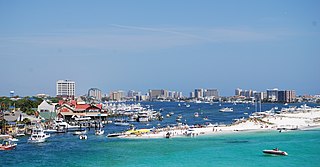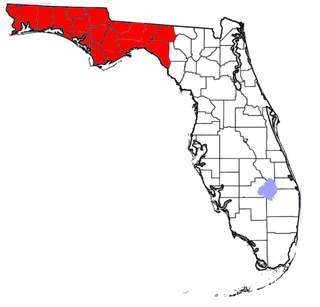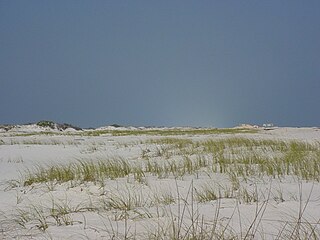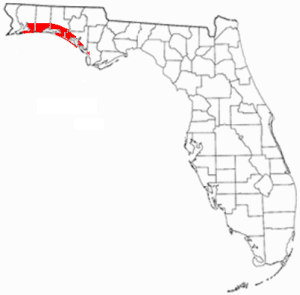
Escambia County is the westernmost and oldest county in the U.S. state of Florida. It is in the state's northwestern corner. At the 2020 census, the population was 321,905. Its county seat and largest city is Pensacola. Escambia County is included within the Pensacola—Ferry Pass—Brent, Florida Metropolitan Statistical Area. The county population has continued to increase as the suburbs of Pensacola have developed.

Okaloosa County is located in the northwestern portion of the U.S. state of Florida, extending from the Gulf of Mexico to the Alabama state line. As of the 2020 census, the population was 211,668. Its county seat is Crestview. Okaloosa County is included in the Crestview-Fort Walton Beach-Destin, FL Metropolitan Statistical Area.

Walton County is located on the Emerald Coast in the northwestern part of the U.S. state of Florida, with its southern border on the Gulf of Mexico. As of the 2020 census, the population was 75,305. Its county seat is DeFuniak Springs. The county is home to the highest natural point in Florida: Britton Hill, at 345 feet (105 m). Walton County is included in the Crestview–Fort Walton Beach–Destin Metropolitan Statistical Area.

Pensacola is the westernmost city in the Florida Panhandle. It is the county seat and only incorporated city of Escambia County, Florida, United States. At the 2020 census, the population was 54,312, up from 51,923 at the 2010 census. It is the principal city of the Pensacola—Ferry Pass—Brent, Florida Metropolitan Statistical Area, which had 509,905 residents in 2020.

Destin is a city located in Okaloosa County, Florida, United States. It is a principal city of the Crestview–Fort Walton Beach–Destin metropolitan area.

Fort Walton Beach, often referred to by the initialism FWB, a city in southern Okaloosa County, Florida, United States. As of the 2020 U.S. census, the population was 20,922, up from 19,507 in 2010. It is the principal city of the Fort Walton Beach−Crestview−Destin Metropolitan Statistical Area.

Gulf Breeze is a city in Santa Rosa County, Florida. It is a suburb of Pensacola, and is in the Pensacola—Ferry Pass—Brent, Florida Metropolitan Statistical Area. The population was 6,340 at the 2020 census, up from 5,763 at the 2010 census.

Jay is a town in Santa Rosa County, Florida, United States. Located in the Florida Panhandle in North Florida, it is part of the Pensacola––Ferry Pass–Brent, Florida Metropolitan Statistical Area. The population was 524 at the 2020 census, down from 533 at the 2010 census.

Pace is an unincorporated community in Santa Rosa County, Florida. It is the second largest community in Santa Rosa County, and is a part of the Pensacola—Ferry Pass—Brent, Florida Metropolitan Statistical Area. Pace has experienced exponential growth, and has evolved from a small, rural community to a thriving bedroom community of Pensacola with growing residential and commercial options. As of the 2020 United States census, the population was 24,684, up from 20,093 at the 2010 census. From 2000 to 2010, the Pace CDP population growth percentage was 171.1%, and from 2010 to 2020, the population growth percentage was 22.8%.

Pensacola Beach is an unincorporated community located on Santa Rosa Island, a barrier island, in Escambia County, Florida, United States. It is situated south of Pensacola in the Gulf of Mexico. As of the 2000 census, the community had a total population of 2,738. It has been described as "famous" for its ultra-white sand beaches.

The Florida panhandle is the northwestern part of the U.S. state of Florida. It is a salient roughly 200 miles (320 km) long, bordered by Alabama on the north and the west, Georgia on the north, and the Gulf of Mexico to the south. Its eastern boundary is arbitrarily defined. It is defined by its southern culture and rural geography relative to the rest of Florida, as well as closer cultural links to French-influenced Louisiana, Mississippi, and Alabama. Its major communities include Pensacola, Navarre, Destin, Panama City Beach, and Tallahassee.

Santa Rosa Island is a 40-mile (64 km) barrier island located in the U.S. state of Florida, thirty miles (50 km) east of the Alabama state border. The communities of Pensacola Beach, Navarre Beach, and Okaloosa Island are located on the island. On the northern side of the island, are Pensacola Bay on the west and Choctawhatchee Bay on the east, joined through Santa Rosa Sound.

The Emerald Coast is an unofficial name for the coastal area in the US state of Florida on the Gulf of Mexico that stretches about 100 miles (160 km) through five counties, Escambia, Santa Rosa, Okaloosa, Walton, and Bay, which include Pensacola Beach, Navarre Beach, Fort Walton Beach, Destin, and Panama City Beach. Some south Alabama communities on the coast of Baldwin County, such as Gulf Shores, Orange Beach, and Fort Morgan embrace the term as well.

Navarre is a census-designated place and unincorporated community in Santa Rosa County in the northwest Florida Panhandle. It is a major bedroom community for mostly U.S. military personnel, federal civil servants, local population, retirees and defense contractors. Due to Navarre Beach and the 4 miles (6.4 km) of beach front on the Gulf of Mexico thereof, as well as several miles of beaches within the Navarre Beach Marine Park and the Gulf Islands National Seashore, it has a small, but rapidly growing community of nature enthusiasts and tourists. Navarre has grown from being a small town of around 1,500 in 1970 to a town with a population estimated at 43,540 as of 2022, if including both the Navarre and Navarre Beach Census Designated Places. The Navarre CDP recorded a population of 40,817 at the 2020 census.

Florida's 1st congressional district is a congressional district in the U.S. state of Florida, covering the state's western Panhandle. It includes all of Escambia, Okaloosa, Santa Rosa counties, and portions of Walton county. The district is anchored in Pensacola and also includes the large military bedroom communities and tourist destinations of Navarre and Fort Walton Beach and stretches along the Emerald Coast. The district is currently represented by Republican Matt Gaetz. With a Cook Partisan Voting Index rating of R+19, it is the most Republican district in Florida.
Santa Rosa Sound is a sound connecting Pensacola Bay and Choctawhatchee Bay in Florida. The northern shore consists of the Fairpoint Peninsula and portions of the mainland in Santa Rosa County and Okaloosa County. It is bounded to the south by Santa Rosa Island, separating it from the Gulf of Mexico.
The Fairpoint Peninsula, also referred to as the Gulf Breeze Peninsula or the Navarre Peninsula or historically the Santa Rosa Peninsula, is located in northwest Florida between Santa Rosa Sound and Pensacola Bay.

The Pensacola metropolitan area is the metropolitan area centered on Pensacola, Florida. It is also known as the Pensacola–Ferry Pass–Brent Metropolitan Statistical Area, a metropolitan statistical area (MSA) used for statistical purposes by the United States Census Bureau and other agencies. The Pensacola Standard Metropolitan Statistical Area was first defined in 1958, with Pensacola as the principal city, and included Escambia and Santa Rosa counties. The MSA was renamed Pensacola–Ferry Pass–Brent MSA in 2003, with the unincorporated census-designated places Ferry Pass and Brent added as principal cities. The population of the MSA in the 2020 census was 511,502.
Midway is an unincorporated community and census designated place (CDP) in southern Santa Rosa County, Florida, United States. It is part of the Pensacola–Ferry Pass–Brent, Florida Metropolitan Statistical Area. The area is located between the communities of Gulf Breeze and Navarre, on the Fairpoint Peninsula. Midway is often considered to be part of one, if not both, of these communities. Its actual boundaries vary from source to source, but unofficially include most areas from the intersection of Soundside Drive with U.S. Highway 98, eastward until Highway 98 becomes Navarre Parkway.
Woodlawn Beach is a census-designated place on Santa Rosa Sound in Santa Rosa County, Florida, United States surrounded by the older Midway CDP. The population was 2,741 at the 2020 census, up from 1,785 at the 2010 Census. It is part of the Pensacola—Ferry Pass—Brent, Florida Metropolitan Statistical Area. It lies south of U.S. Highway 98 between Nantahala Beach Road and Conover Cove, and includes the Woodlawn Beach Middle School, Woodlawn Beach Boat Ramp, and Gulf Breeze Zoo. Citizens of Woodlawn Beach often consider themselves to be part of the larger communities of Navarre or Gulf Breeze. The ZIP Code for Woodlawn Beach is 32563.























